
Titanite, or sphene (from Ancient Greek σφηνώ (sphēnṓ) 'wedge'), is a calcium titanium nesosilicate mineral, CaTiSiO5. Trace impurities of iron and aluminium are typically present. Also commonly present are rare earth metals including cerium and yttrium; calcium may be partly replaced by thorium.
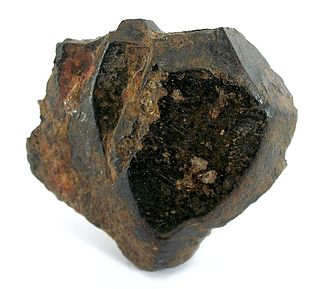
Ilmenite is a titanium-iron oxide mineral with the idealized formula FeTiO
3. It is a weakly magnetic black or steel-gray solid. Ilmenite is the most important ore of titanium and the main source of titanium dioxide, which is used in paints, printing inks, fabrics, plastics, paper, sunscreen, food and cosmetics.
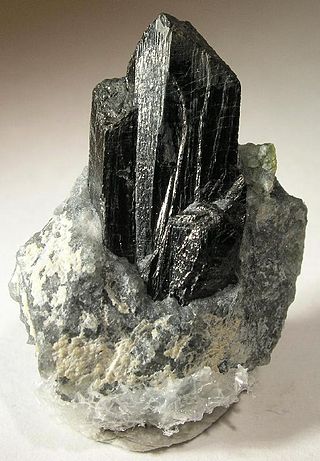
Baddeleyite is a rare zirconium oxide mineral (ZrO2 or zirconia), occurring in a variety of monoclinic prismatic crystal forms. It is transparent to translucent, has high indices of refraction, and ranges from colorless to yellow, green, and dark brown. See etymology below.

Euxenite, or euxenite-(Y), is a brownish black mineral with a metallic luster.
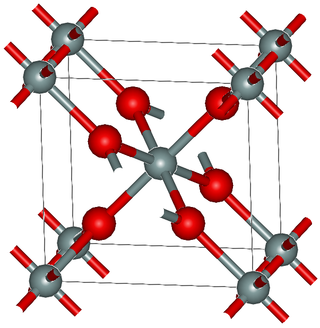
Stishovite is an extremely hard, dense tetragonal form (polymorph) of silicon dioxide. It is very rare on the Earth's surface; however, it may be a predominant form of silicon dioxide in the Earth, especially in the lower mantle.
Aeschynite-(Ce) is a rare earth mineral of cerium, calcium, iron, thorium, titanium, niobium, oxygen, and hydrogen with chemical formula (Ce,Ca,Fe,Th)(Ti,Nb)2(O,OH)6. Its name comes from the Greek word αισχύνη ("aeschyne") for "shame" because early chemists had difficulty with separations of titanium from zirconium.
Aeschynite-(Nd) is a rare earth mineral of neodymium, cerium, calcium, thorium, titanium, niobium, oxygen, and hydrogen with the chemical formula (Nd,Ce,Ca,Th)(Ti,Nb)2(O,OH)6. Its name comes from the Greek word for "shame". Its Mohs scale rating is 5 to 6. It is a member of the hydroxide minerals.
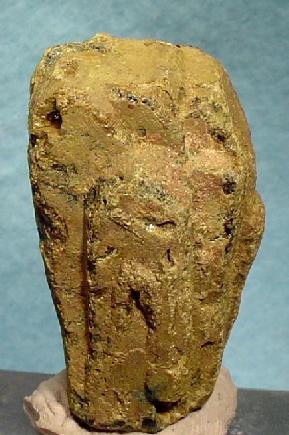
Aeschynite-(Y) is a rare earth mineral of yttrium, calcium, iron, thorium, titanium, niobium, oxygen, and hydrogen with the chemical formula (Y,Ca,Fe,Th)(Ti,Nb)2(O,OH)6. Its name comes from the Greek word for "shame". Its Mohs scale rating is 5 to 6.
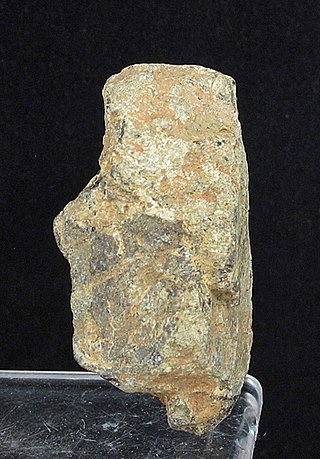
Polycrase or polycrase-(Y) is a black or brown metallic complex uranium yttrium oxide mineral with the chemical formula (Y,Ca,Ce,U,Th)(Ti,Nb,Ta)2O6. It is amorphous. It has a Mohs hardness of 5 to 6 and a specific gravity of 5. It is radioactive due to its uranium content. It occurs in granitic pegmatites.
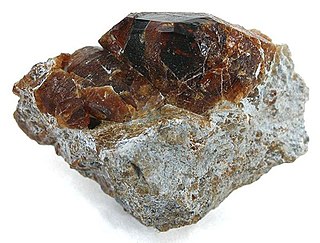
Chondrodite is a nesosilicate mineral with formula (Mg,Fe)
5(SiO
4)
2(F,OH,O)
2. Although it is a fairly rare mineral, it is the most frequently encountered member of the humite group of minerals. It is formed in hydrothermal deposits from locally metamorphosed dolomite. It is also found associated with skarn and serpentinite. It was discovered in 1817 at Pargas in Finland, and named from the Greek for "granule", which is a common habit for this mineral.
Zircophyllite is a complex mineral, formula (K,Na)3(Mn,Fe)2+7(Zr,Ti,Nb)2Si8O24(OH,F)7. It crystallizes in the triclinic – pinacoidal crystal class as dark brown to black micaceous plates. It has perfect 001 cleavage, a Mohs hardness of 4 to 4.5 and a specific gravity of 3.34. Its indices of refraction are nα=1.708 nβ=1.738 nγ=1.747 and it has a 2V optical angle of 62°.

Pabstite is a barium tin titanium silicate mineral that is found in contact metamorphosed limestone. It belongs to the benitoite group of minerals. The chemical formula of pabstite is Ba(Sn,Ti)Si3O9. It is found in Santa Cruz, California. The crystal system of the mineral is hexagonal.

Betafite is a mineral group in the pyrochlore supergroup, with the chemical formula (Ca,U)2(Ti,Nb,Ta)2O6(OH). Betafite typically occurs as a primary mineral in granite pegmatites, rarely in carbonatites. Originally defined by the B-site atom Ti, the development of new nomenclature for mineral names led to modernization of the system for nomenclature of pyrochlore and betafite in order to further rationalize the naming process of this grouping of minerals. Only two of the mineral species that were formerly recognized as betafite are presently retained. They are oxyuranobetafite and oxycalciobetafite. The term betafite is now a synonym or varietal group name under the pyrochlore super group.

Perovskite (pronunciation: ) is a calcium titanium oxide mineral composed of calcium titanate (chemical formula CaTiO3). Its name is also applied to the class of compounds which have the same type of crystal structure as CaTiO3, known as the perovskite structure, which has a general chemical formula A2+B4+(X2−)3. Many different cations can be embedded in this structure, allowing the development of diverse engineered materials.

Perhamite is a phosphate mineral with the formula Ca3Al7(SiO4)3(PO4)4(OH)3·16.5(H2O). It occurs in rare isolated masses in amblygonite-rich pegmatite deposits throughout the world. It was discovered in platy sheed form of 1mm hexagonal crystals. It was first described in 1977 by P.J. Dunn and D.E. Appleman from pegmatite collected from Bell Pit, Newry, Maine. Other specimens have been found in Kapunda, South Australia, in Silver Coin mine near Humboldt County, Nevada and various locations throughout Europe.

Geikielite is a magnesium titanium oxide mineral with formula: MgTiO3. It is a member of the ilmenite group. It crystallizes in the trigonal system forming typically opaque, black to reddish black crystals.

Narsarsukite is a rare silicate mineral with either the chemical formula Na2(Ti,Fe3+)Si4(O,F)11 or Na4(Ti,Fe)4[Si8O20](O,OH,F)4.
Akaogiite (IMA symbol Aka) is an exceedingly rare mineral, one of the natural forms of titanium dioxide (TiO2). It is a high-pressure polymorph of TiO2, along with anatase, brookite and another high-pressure phase called "TiO2 II". Rutile is the stable polymorph of TiO2, most commonly found at standard temperatures and pressures.

Lamprophyllite is a rare, but widespread mineral Ti-silicate mineral usually found in intrusive agpasitic igneous rocks. Yellow, reddish brown, Vitreous, Pearly.
Achalaite ((Fe2+, Mn)(Ti, Fe3+, Ta)(Nb, Ta)2O8) is a black mineral of the wodginite group, first discovered in 2013.















